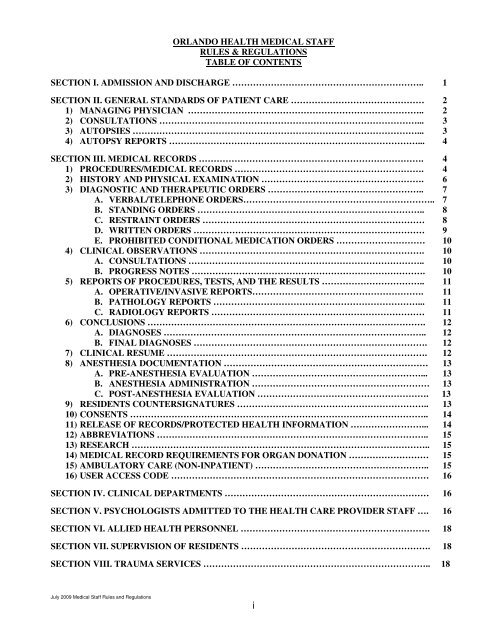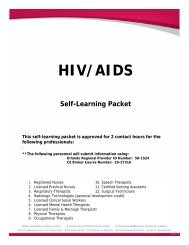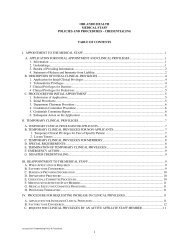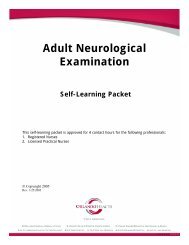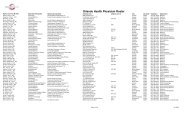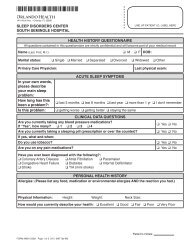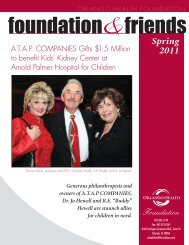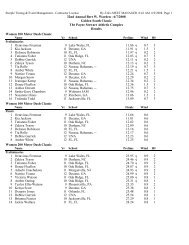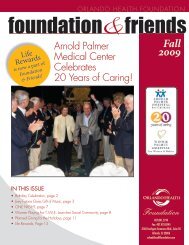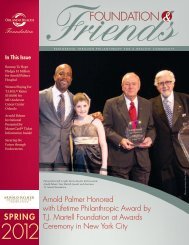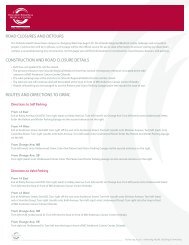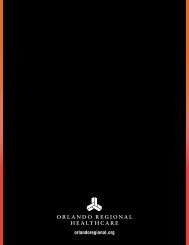orlando health medical staff rules & regulations table of contents ...
orlando health medical staff rules & regulations table of contents ...
orlando health medical staff rules & regulations table of contents ...
Create successful ePaper yourself
Turn your PDF publications into a flip-book with our unique Google optimized e-Paper software.
ORLANDO HEALTH MEDICAL STAFF<br />
RULES & REGULATIONS<br />
TABLE OF CONTENTS<br />
SECTION I. ADMISSION AND DISCHARGE ……………………………………………………….. 1<br />
SECTION II. GENERAL STANDARDS OF PATIENT CARE ……………………………………… 2<br />
1) MANAGING PHYSICIAN …………………………………………………………………….. 2<br />
2) CONSULTATIONS ……………………………………………………………………………... 3<br />
3) AUTOPSIES ……………………………………………………………………………………... 3<br />
4) AUTOPSY REPORTS …………………………………………………………………………... 4<br />
SECTION III. MEDICAL RECORDS …………………………………………………………………. 4<br />
1) PROCEDURES/MEDICAL RECORDS ………………………………………………………. 4<br />
2) HISTORY AND PHYSICAL EXAMINATION ………………………………………………. 6<br />
3) DIAGNOSTIC AND THERAPEUTIC ORDERS …………………………………………….. 7<br />
A. VERBAL/TELEPHONE ORDERS……………………………………………………….. 7<br />
B. STANDING ORDERS ………………………………………………………………….. 8<br />
C. RESTRAINT ORDERS ………………………………………………………………… 8<br />
D. WRITTEN ORDERS …………………………………………………………………… 9<br />
E. PROHIBITED CONDITIONAL MEDICATION ORDERS ………………………… 10<br />
4) CLINICAL OBSERVATIONS …………………………………………………………………. 10<br />
A. CONSULTATIONS …………………………………………………………………….. 10<br />
B. PROGRESS NOTES ……………………………………………………………………. 10<br />
5) REPORTS OF PROCEDURES, TESTS, AND THE RESULTS …………………………….. 11<br />
A. OPERATIVE/INVASIVE REPORTS…………………………………………………. 11<br />
B. PATHOLOGY REPORTS ……………………………………………………………... 11<br />
C. RADIOLOGY REPORTS ……………………………………………………………… 11<br />
6) CONCLUSIONS …………………………………………………………………………………. 12<br />
A. DIAGNOSES …………………………………………………………………………….. 12<br />
B. FINAL DIAGNOSES ……………………………………………………………………. 12<br />
7) CLINICAL RESUME ……………………………………………………………………………. 12<br />
8) ANESTHESIA DOCUMENTATION …………………………………………………………… 13<br />
A. PRE-ANESTHESIA EVALUATION …………………………………………………... 13<br />
B. ANESTHESIA ADMINISTRATION …………………………………………………… 13<br />
C. POST-ANESTHESIA EVALUATION …………………………………………………. 13<br />
9) RESIDENTS COUNTERSIGNATURES ……………………………………………………….. 13<br />
10) CONSENTS ……………………………………………………………………………………….. 14<br />
11) RELEASE OF RECORDS/PROTECTED HEALTH INFORMATION ……………………... 14<br />
12) ABBREVIATIONS ……………………………………………………………………………….. 15<br />
13) RESEARCH ……………………………………………………………………………………….. 15<br />
14) MEDICAL RECORD REQUIREMENTS FOR ORGAN DONATION ……………………… 15<br />
15) AMBULATORY CARE (NON-INPATIENT) ………………………………………………….. 15<br />
16) USER ACCESS CODE …………………………………………………………………………… 16<br />
SECTION IV. CLINICAL DEPARTMENTS …………………………………………………………… 16<br />
SECTION V. PSYCHOLOGISTS ADMITTED TO THE HEALTH CARE PROVIDER STAFF …. 16<br />
SECTION VI. ALLIED HEALTH PERSONNEL ………………………………………………………. 18<br />
SECTION VII. SUPERVISION OF RESIDENTS ………………………………………………………. 18<br />
SECTION VIII. TRAUMA SERVICES ………………………………………………………………….. 18<br />
July 2009 Medical Staff Rules and Regulations<br />
i
RULES AND REGULATIONS<br />
OF THE MEDICAL STAFF OF<br />
ORLANDO REGIONAL HEALTHCARE SYSTEM, INC.<br />
ADMISSION AND DISCHARGE OF PATIENTS<br />
Physicians, dentists, and podiatrists requesting admission for private patients shall<br />
provide the hospital with a provisional diagnosis and will give such other information as<br />
may be required to enable the hospital to take such action as is necessary to protect<br />
patients already in the hospital from patients who are or may become a source <strong>of</strong> danger<br />
from any cause whatever.<br />
Emergency patients may be admitted without data required in Number 1, but the<br />
attending physician, dentist, or podiatrist will be expected to furnish such data within<br />
twenty-four (24) hours after admission <strong>of</strong> the patient.<br />
3. All unassigned patients shall be attended by members <strong>of</strong> the Active Staff, Senior Staff<br />
and Active Associate Staff if requested by the department chairman. Unassigned patients<br />
shall be assigned to the service concerned in the treatment <strong>of</strong> the disease which<br />
necessitated the admission. No physician, dentist, or podiatrist shall refuse treatment <strong>of</strong> a<br />
patient because <strong>of</strong> lack <strong>of</strong> compensation. Patients with personal physicians, dentists, or<br />
podiatrists shall be attended by their personal physicians, dentists, or podiatrists. (01/07)<br />
For purposes <strong>of</strong> defining the pediatric age group for assignment <strong>of</strong> unassigned patients,<br />
patients under the age <strong>of</strong> sixteen (16) years shall be considered pediatric, and patients age<br />
sixteen (16) years and older shall be considered adult, unless otherwise defined by<br />
mutual agreement <strong>of</strong> the applicable adult and pediatric clinical departments on file with<br />
the Medical Affairs Administration and in their respective departmental Rules and<br />
Regulations. (07/06)<br />
5. Patients shall not be discharged from the hospital until a provisional or final discharge<br />
diagnosis has been written on the chart by the physician, dentist or podiatrist or by the<br />
nurse on verbal order from the physician, dentist, or podiatrist.<br />
6. When a woman presents to the obstetrical triage department for evaluation, a qualified<br />
triage core nurse who has met criteria established by the Department <strong>of</strong> Ob/Gyn, may<br />
conduct an appropriate <strong>medical</strong> screening examination and report the results <strong>of</strong> such<br />
examination to the responsible physician who will determine whether the woman has an<br />
emergency <strong>medical</strong> condition. If the case is beyond the nurse’s expertise or training, the<br />
responsible physician must conduct further screening as appropriate. If it appears that a<br />
non-pregnancy-related emergency <strong>medical</strong> condition may be present, the patient may be<br />
taken to the Emergency Department for further evaluation or an appropriate consultant<br />
may be called in to evaluate the patient. (03/05)<br />
July 2009 Medical Staff Rules and Regulations<br />
1
GENERAL STANDARDS OF PATIENT CARE<br />
A hospital formulary will be prepared and kept up to date by the hospital pharmacist with<br />
the approval and under the direction <strong>of</strong> the Pharmacotherapeutics Committee <strong>of</strong> the<br />
<strong>medical</strong> <strong>staff</strong>. Acceptance <strong>of</strong> these bylaws, <strong>rules</strong> and <strong>regulations</strong> also specifically implies<br />
acceptance <strong>of</strong> this formulary and its use.<br />
Medications and prescriptions brought into the hospital by patients must have written<br />
orders by the attending physician, surgeon, dentist, or podiatrist stipulating the dosage<br />
indicating his or her assumption <strong>of</strong> full responsibility for such medication, which the<br />
patient may self administer. Patients without such orders will not be permitted to use<br />
their own medications while a patient in this hospital.<br />
All surgical specimens, other than approved exceptions, shall be sent to the hospital<br />
pathologist who shall make such examinations as he or she shall consider necessary to<br />
arrive at a pathological diagnosis.<br />
Each patient in the hospital shall be seen at least once daily or every twenty four hours by<br />
his or her attending physician, dentist, or podiatrist or some other <strong>medical</strong> <strong>staff</strong> member<br />
designated by the attending physician, dentist, or podiatrist, with the exception <strong>of</strong><br />
patients admitted for long term care and rehabilitative care, who shall be seen in<br />
accordance with applicable standards. (05/06)<br />
Each member <strong>of</strong> the <strong>medical</strong> <strong>staff</strong> not readily available shall designate an alternate. In<br />
case <strong>of</strong> failure to name such alternate, the Chief Executive Officer <strong>of</strong> the hospital or the<br />
Chief Executive Officer's designee shall have the authority to call any member <strong>of</strong> the<br />
<strong>medical</strong> <strong>staff</strong>, should he or she consider it necessary. Each member <strong>of</strong> the <strong>medical</strong> <strong>staff</strong>,<br />
except the Honorary Medical Staff, shall keep the Chief Executive Officer <strong>of</strong> the<br />
hospital (or the Chief Executive Officer’s designee) informed <strong>of</strong> his or her correct<br />
address and telephone number.<br />
Designation and Responsibilities <strong>of</strong> Managing Physician (01/07)<br />
There shall be a managing physician for every patient admitted to ORHS.<br />
The attending physician will e considered the managing physician unless otherwise<br />
specified under physician orders. (An attending physician refers to an admitting<br />
physician.)<br />
(1) The name <strong>of</strong> the managing physician will be clearly specified on the front <strong>of</strong> the<br />
chart at all times.<br />
(2) Any change in the managing physician during the stay <strong>of</strong> the patient requires a<br />
physician order.<br />
Responsibilities <strong>of</strong> the managing physician:<br />
(1) The managing physician will be responsible for coordination <strong>of</strong> the patient’s care.<br />
July 2009 Medical Staff Rules & Regulations<br />
2
(2) The managing physician will be available for communication with the patient’s<br />
family on a routine basis.<br />
(3) Should there be a conflict in patient care occur, the managing physician will be<br />
responsible for resolving the conflict.<br />
D. Patients with a primary surgical problem will be admitted to a surgeon.<br />
(1) Patients with a primary surgical problem within thirty (30) days <strong>of</strong> surgery will<br />
be admitted to their surgeon <strong>of</strong> record.<br />
(2) Patients admitted for a non-surgical problem within thirty (30) days <strong>of</strong> surgery<br />
will have their surgeon <strong>of</strong> record notified <strong>of</strong> their admission.<br />
(3) The attending physician will notify the surgeon <strong>of</strong> record.<br />
E. Physicians providing coverage for the managing physician will assume all<br />
responsibilities <strong>of</strong> the managing physician.<br />
7. CONSULTATIONS<br />
8. AUTOPSIES<br />
Consultant: A consultant must be well qualified to give an opinion in the field in<br />
which his or her opinion is sought. He or she shall be a member in good standing <strong>of</strong><br />
the ORHS <strong>medical</strong> <strong>staff</strong>.<br />
The consultant shall make and sign a record <strong>of</strong> his or her findings and<br />
recommendations. (Description <strong>of</strong> "Consultation" is included in Section III, Number<br />
4 (A)<br />
There must be evidence <strong>of</strong> consultation with a qualified child psychiatrist when other<br />
special treatment procedures are used for children and adolescents. This pertains to<br />
treatments that are outside the realm <strong>of</strong> general <strong>medical</strong> practice.<br />
Every member <strong>of</strong> the <strong>medical</strong> <strong>staff</strong> shall be actively interested in securing autopsies<br />
whenever a death occurs that meets the following criteria. All autopsies shall be<br />
performed by a hospital pathologist or by a physician to whom the hospital<br />
pathologist may delegate the duty.<br />
Indications for Performing Autopsies:<br />
Deaths in which an autopsy may help explain unknown and unanticipated<br />
<strong>medical</strong> complications to the attending physician.<br />
All deaths in which the cause <strong>of</strong> death or a major diagnosis is not known with<br />
reasonable certainty on clinical grounds.<br />
Cases in which autopsy may help allay concerns <strong>of</strong>, and provide reassurance<br />
to, the family and/or the public regarding the death.<br />
July 2009 Medical Staff Rules & Regulations<br />
3
Unexpected or unexplained deaths during the following: any dental, <strong>medical</strong><br />
or surgical procedure and/or therapies.<br />
Deaths <strong>of</strong> patients who have participated in clinical trials approved by the<br />
institutional review board.<br />
Unexpected or unexplained deaths that are apparently natural and not subject<br />
to forensic jurisdiction.<br />
Natural deaths that are subject to, but waived by a forensic <strong>medical</strong><br />
jurisdiction, such as persons dead on arrival at hospital; deaths occurring in<br />
hospitals within 24 hours <strong>of</strong> admissions; and deaths in which the patient<br />
sustained an injury while hospitalized.<br />
Deaths resulting from high-risk infections and contagious diseases.<br />
All obstetric deaths.<br />
All perinatal and pediatric deaths.<br />
Deaths in which it is believed that an autopsy would disclose a known or<br />
suspected illness that may have bearing on survivors or recipients <strong>of</strong><br />
transplant organs.<br />
Deaths known or suspected to have resulted from environmental or<br />
occupational hazards.<br />
B. AUTOPSY REPORTS<br />
When an autopsy is performed, provisional anatomic diagnoses should be<br />
recorded in the <strong>medical</strong> record within two (2) working days, and the complete<br />
protocol should be made part <strong>of</strong> the record within forty-two (42) days with rare<br />
exceptions for complex cases.<br />
SECTION III. MEDICAL RECORDS<br />
1. PROCEDURES/MEDICAL RECORDS<br />
The attending physician, dentist, or podiatrist shall be responsible for the preparation<br />
<strong>of</strong> a complete and legible <strong>medical</strong> record for each patient. Its <strong>contents</strong> shall be<br />
pertinent and current and contain sufficient information to identify the patient, to<br />
support the diagnosis and the treatment, and to document the results accurately.<br />
All clinical entries in the patient's <strong>medical</strong> record shall be accurately and legibly<br />
dated, contain no prohibited abbreviations, and be signed by the physician, dentist, or<br />
July 2009 Medical Staff Rules & Regulations<br />
4
podiatrist initiating the order or report. A physician group can permit their partners to<br />
sign for each other. Authorization is granted by having a signed affidavit on file in<br />
the HIM Department. All errors noted in the <strong>medical</strong> record shall be single-lined out,<br />
noted as error, and legibly dated and initialed.<br />
A <strong>medical</strong> record shall be considered complete when the required <strong>contents</strong> are<br />
assembled and signed following discharge <strong>of</strong> the patient. Failure <strong>of</strong> the <strong>medical</strong> <strong>staff</strong><br />
member to complete <strong>medical</strong> records within thirty (30) days <strong>of</strong> discharge and after<br />
written warning <strong>of</strong> such delinquency shall be grounds for automatically relinquishing<br />
a <strong>staff</strong> member's elective admitting and surgical privileges.<br />
A <strong>medical</strong> <strong>staff</strong> member who is ill or on vacation or leave <strong>of</strong> absence shall not be<br />
penalized for having incomplete <strong>medical</strong> records, providing he or she notifies the<br />
Corporate Director <strong>of</strong> the Health Information Management Department. The <strong>medical</strong><br />
<strong>staff</strong> member will be given three (3) days from the time he or she again becomes<br />
available to satisfy the 30-day requirement. Extension shall not apply to absences <strong>of</strong><br />
less than three (3) days, or in instances where records are delinquent prior to<br />
departure.<br />
Medical records shall not be filed until complete, except on order <strong>of</strong> the Medical<br />
Record Committee.<br />
Chronic failure <strong>of</strong> a <strong>medical</strong> <strong>staff</strong> member to maintain complete, accurate, and timely<br />
records <strong>of</strong> his or her patients will be reported to the respective department chairman.<br />
Automatic loss <strong>of</strong> all hospital privileges will result for any <strong>staff</strong> member whose<br />
suspension continues in effect in excess <strong>of</strong> fourteen (14) days following the onset <strong>of</strong><br />
suspension <strong>of</strong> admitting and surgery privileges for failure to complete <strong>medical</strong><br />
records. Only upon completion <strong>of</strong> all <strong>medical</strong> records and payment <strong>of</strong> the application<br />
fee together with a $500 fine may the individual then reapply through the Credentials<br />
Committee as a new applicant for <strong>medical</strong> <strong>staff</strong> privileges.<br />
Eight suspensions within a two-year reappointment period for failure to complete<br />
<strong>medical</strong> records will result in a fine <strong>of</strong> $1000 or a requirement <strong>of</strong> three (3) hours <strong>of</strong><br />
approved Continuing Medical Education on <strong>medical</strong> records management.<br />
Thereafter, every third suspension within the same two-year reappointment period<br />
will result in an additional fine <strong>of</strong> $1000 with no option for substitution <strong>of</strong> Continuing<br />
Medical Education in lieu <strong>of</strong> the fine. The failure to pay any fine when due (or to<br />
attend continuing <strong>medical</strong> education, if applicable) will be considered a voluntary<br />
resignation from the <strong>medical</strong> <strong>staff</strong> and the individual may reapply as a new applicant<br />
only upon completion <strong>of</strong> all <strong>medical</strong> records and payment <strong>of</strong> all applicable fines and<br />
fees. (01/03)<br />
H. Any chart that does not have the physician’s dictation number on all written orders is<br />
considered incomplete. Failure to use the assigned four-digit dictation number on a<br />
written order will result in the following action: (09/06)<br />
July 2009 Medical Staff Rules & Regulations<br />
5
First incident:<br />
Second incident:<br />
Third incident:<br />
Fourth incident:<br />
Fifth incident:<br />
the <strong>medical</strong> <strong>staff</strong> member will receive a call from the department<br />
chair or designee.<br />
the member will receive call from the Leadership Chair and/or<br />
Chief <strong>of</strong> Staff.<br />
the member will be required to appear before the Medical Staff<br />
<strong>of</strong>ficers.<br />
the member will be required to appear before the respective<br />
Leadership Committee and/or MEC.<br />
the member will be required to attend an approved three hour<br />
CME course or pay a fine <strong>of</strong> $500. Failure to attend approved<br />
CME course or pay fine when due will be considered a voluntary<br />
resignation from the <strong>medical</strong> <strong>staff</strong> and the individual may reapply<br />
as a new applicant only upon completion <strong>of</strong> all <strong>medical</strong> records<br />
and payment <strong>of</strong> all applicable fines and fees.<br />
HISTORY AND PHYSICAL EXAMINATION (07/05)<br />
Medical history and physical examination must be completed no more than 30 days<br />
before or 24 hours after admission for each patient by a physician or other qualified<br />
individual who has been granted these privileges by the <strong>medical</strong> <strong>staff</strong> in accordance<br />
with State law. The <strong>medical</strong> history and physical examination must be placed in the<br />
patient’s <strong>medical</strong> record within 24 hours after admission.<br />
When the <strong>medical</strong> history and physical examination are completed within 30 days<br />
before admission, there must be an updated <strong>medical</strong> record entry documenting an<br />
examination for any changes in the patient’s condition. This updated examination<br />
must be completed and documented in the patient’s <strong>medical</strong> record within 24 hours<br />
after admission.<br />
An H&P performed more than 30 days prior to hospital admission/outpatient surgery<br />
does not comply with the currency requirements and a new H&P must be performed.<br />
The history and physical examination, the results <strong>of</strong> any indicated diagnostic tests, as<br />
well as a provisional diagnosis are recorded before the operative or other procedures,<br />
with the exception <strong>of</strong> emergencies, by the physician responsible for the patient (prior<br />
to surgery or any potentially hazardous diagnostic procedure).<br />
E. A pre-anesthesia evaluation by a qualified individual must be performed and must be<br />
in the <strong>medical</strong> record prior to surgery.<br />
July 2009 Medical Staff Rules & Regulations<br />
6
F. The <strong>medical</strong> history should include the chief complaint, details <strong>of</strong> the present illness<br />
(including, when appropriate, assessment <strong>of</strong> the patient’s emotional, behavioral and<br />
social status), relevant past, social and family histories, and an inventory <strong>of</strong> body<br />
systems. The physical examination shall reflect a comprehensive current physical<br />
assessment. The history and physical must also include a statement <strong>of</strong> the<br />
conclusions or impressions drawn from the history and physical, and a statement <strong>of</strong><br />
the course <strong>of</strong> action planned for the patient while in the hospital.<br />
Newborn records must document a complete physical examination on birth and again<br />
prior to discharge; provide that, if the infant is discharged within 36 hours <strong>of</strong> birth,<br />
with the diagnosis <strong>of</strong> “Term Male (Female) Delivery” (ICDV30-39) and with no<br />
other diagnosis than newborn physiologic jaundice (ICD 774.6), the birth and<br />
discharge examinations may be one and the same.<br />
Patients admitted for dental care must have a history and physical and evaluation <strong>of</strong><br />
overall <strong>medical</strong> risk by a physician member <strong>of</strong> the <strong>medical</strong> <strong>staff</strong>. The dentist is<br />
responsible for that part <strong>of</strong> the history and physical related to dentistry. Qualified<br />
oral-maxill<strong>of</strong>acial surgeons who admit patients without <strong>medical</strong> problems may<br />
perform the <strong>medical</strong> history and physical examinations on those patients if they have<br />
such privileges.<br />
I. Patients admitted for podiatric care must have a history and physical and evaluation<br />
<strong>of</strong> overall <strong>medical</strong> risk by a physician member <strong>of</strong> the <strong>medical</strong> <strong>staff</strong>. The podiatrist is<br />
responsible for that part <strong>of</strong> the history and physical related to podiatry.<br />
DIAGNOSTIC AND THERAPEUTIC ORDERS<br />
Orders must be written clearly, legibly, and completely, including date and time. (11/07)<br />
VERBAL/TELEPHONE ORDERS (11/07)<br />
(1) The use <strong>of</strong> verbal/telephone orders is discouraged. If verbal/telephone orders<br />
are used, they should be used only infrequently and should be limited to those<br />
situations in which it is impossible or impractical for the ordering practitioner to<br />
write the order either manually or electronically. Verbal/telephone orders are<br />
not to be used solely for the convenience <strong>of</strong> the ordering practitioner.<br />
(2) All verbal orders shall be read back to the person dictating the order to verify<br />
accuracy.<br />
All verbal/telephone orders shall be signed by the registered nurse or other<br />
authorized personnel to whom dictated with the name <strong>of</strong> the physician by his or<br />
her name. Categories <strong>of</strong> persons authorized to accept verbal/telephone orders<br />
and write or electronically generate those orders through ORHS’s automated<br />
order entry system are:<br />
July 2009 Medical Staff Rules & Regulations<br />
7
Registered nurses, advanced registered nurse practitioners, certified<br />
registered nurse anesthetists and graduate nurses<br />
Physician assistants<br />
Respiratory therapists<br />
Radiology technicians<br />
Laboratory technicians<br />
Licensed practical nurses<br />
Registered rehabilitation therapists, e.g. physiotherapists, speech therapists<br />
and occupational <strong>health</strong> therapists and audiologists<br />
Orthopedic technicians<br />
Registered pharmacists and registered pharmacy interns<br />
Registered dieticians<br />
Social work discharge planners<br />
Licensed clinical social workers, licensed mental <strong>health</strong> counselors and<br />
licensed marriage/family therapists<br />
All verbal/telephone orders must be authenticated by the physician, dentist, or<br />
podiatrist initiating the order (or by a group member who is authorized to sign<br />
for that individual under Section III.1.B. above). Verbal/telephone orders<br />
should be authenticated at the next opportunity (i.e., the next time the patient is<br />
assessed and/or information is documented in the <strong>medical</strong> record) and must be<br />
authenticated within 24 hours when such orders prescribe controlled drugs, Do<br />
Not Resuscitate and Restraint and within 48 hours for all other orders. (11/07)<br />
B. STANDING ORDERS/ORDER SETS<br />
Standing orders/order sets may be used by individual physicians, dentists, or<br />
podiatrists. These orders shall be followed ins<strong>of</strong>ar as proper treatment <strong>of</strong> the patient<br />
will allow, and when specific orders are not written by the attending physician,<br />
dentist, or podiatrist they shall constitute the orders for treatment. Standing<br />
orders/order sets shall not, however, replace or cancel those written for the specific<br />
patient.<br />
C. RESTRAINT ORDERS<br />
July 2009 Medical Staff Rules & Regulations<br />
8
A physician’s order is required for <strong>medical</strong>/surgical restraint and behavioral<br />
management restraint use. Written or verbal orders for initial or continued restraint<br />
use are time limited. Behavioral management restraint use requires a physician’s<br />
face-to-face assessment within one (1) hour <strong>of</strong> initiation.<br />
D. WRITTEN ORDERS<br />
Written orders must be legible.<br />
Print must be large enough to reproduce easily by fax or copy.<br />
Abbreviations may not be used for medication names. All other abbreviations<br />
must conform to the approved abbreviation list.<br />
(4) Orders must be written with pens/devices capable <strong>of</strong> transferring legibly<br />
through multiple copies. Felt tip pens may not be used.<br />
(5) Changes to existing orders must be made by way <strong>of</strong> new orders. Existing<br />
orders may not be corrected/scratched over.<br />
(6) All admitting orders must include patient allergies.<br />
(7) All physician orders must be accompanied by a legible identifier consisting <strong>of</strong><br />
the physician’s assigned four-digit dictation number, in addition to the<br />
prescriber’s signature. (05/06)<br />
(8) All orders, to be complete, must contain date written, medication name,<br />
dose/strength, quantity or duration (as appropriate), route and frequency.<br />
Direct admissions must be accompanied by physician orders.<br />
(10) Patients undergoing a change in level <strong>of</strong> care must have current orders<br />
reviewed and signed.<br />
The patient’s full name must be documented on the order sheet prior to order<br />
being written.<br />
Physician must attempt to use Orlando Regional order sheets or <strong>of</strong>fice<br />
letterhead for direct admissions.<br />
(13) Medication Orders<br />
Abbreviations may not be used for medication names. All other<br />
abbreviations must conform to the approved abbreviation list.<br />
Orders should include height/weight/allergy/creatinine where applicable.<br />
July 2009 Medical Staff Rules & Regulations<br />
9
1. Chemotherapy orders should include patient height, current weight, and<br />
body surface area, where applicable.<br />
2. Pediatric orders should include patient weight, and mg per kg/dose.<br />
All PRN orders must include indication and dosing schedule.<br />
Medication orders should not contain trailing zeros (i.e. 5 mg vs. 5.0<br />
mg), should include a pre-decimal zero where applicable (i.e. 0.5 mg vs<br />
.5 mg), and units should be spelled out (i.e. Units vs. U.).<br />
(14) Each individual order must be rewritten postoperatively. “Resume pre-op orders”<br />
or similar notation is not sufficient. (07/05)<br />
E. PROHIBITED CONDITIONAL MEDICATION ORDERS (01/07)<br />
Any medication order that is conditional upon another prescriber’s approval is not<br />
allowed.<br />
4. CLINICAL OBSERVATIONS<br />
CONSULTATIONS<br />
The consultation request shall include the reason as stated by the attending<br />
physician, dentist, or podiatrist. The consultation report shall reflect evidence <strong>of</strong><br />
a review <strong>of</strong> the <strong>medical</strong> record, actual examination <strong>of</strong> the patient, pertinent<br />
findings, opinions, and recommendations.<br />
Refer to "General Standards <strong>of</strong> Patient Care" for cases in which a consultation is<br />
required.<br />
PROGRESS NOTES<br />
All <strong>medical</strong> <strong>staff</strong> progress notes shall be dated and signed by the physician,<br />
dentist, or podiatrist who recorded them and will give a pertinent chronological<br />
order <strong>of</strong> the patient's course in the hospital.<br />
Whenever possible, each <strong>of</strong> the patient's clinical problems will be clearly<br />
identified in the progress notes as well as results <strong>of</strong> tests and treatment. They<br />
shall be recorded at the time <strong>of</strong> observation and written to permit continuity <strong>of</strong><br />
care and transferability <strong>of</strong> the patient. Progress notes shall be written at least<br />
daily, except in Rehabilitation Units where inpatients will be seen and progress<br />
notes recorded at least three times per week. For stays <strong>of</strong> less than 48 hours, a<br />
final progress note will be made upon discharge.<br />
(3) There must be evidence on the progress notes <strong>of</strong> the <strong>medical</strong> record that includes<br />
justification for the use <strong>of</strong> special procedures. Special procedures that require<br />
special justification include the following:<br />
July 2009 Medical Staff Rules & Regulations<br />
10
Restraint or seclusion;<br />
Electroconvulsive and other forms <strong>of</strong> convulsive therapy;<br />
Psychosurgery or other surgical procedures that alter or intervene in an<br />
emotional, mental, or behavioral disorder;<br />
(d) Other special treatment procedures for children and adolescents.<br />
Indications for use <strong>of</strong> blood products must be documented in the <strong>medical</strong> record.<br />
5. REPORTS OF PROCEDURES, TESTS AND THE RESULTS<br />
OPERATIVE/INVASIVE REPORTS<br />
A comprehensive operative/invasive procedure report must be dictated or written<br />
immediately following a surgical or invasive procedure. If dictated, a brief<br />
operative/invasive progress note must be hand written in the <strong>medical</strong> record<br />
immediately after surgery in order to provide pertinent information for use by any<br />
practitioner required to attend the patient.<br />
The dictated operative/invasive procedure report must contain the pre and<br />
postoperative diagnoses, the name <strong>of</strong> the primary surgeon and any assistants,<br />
the procedure performed, a detailed description <strong>of</strong> the procedure performed, to<br />
include the technical procedure used, the findings, the specimens removed,<br />
estimated blood loss, amount <strong>of</strong> any blood transfused, complications, patient's<br />
condition on leaving operating room.<br />
The operative progress note must contain the pre and postoperative diagnoses,<br />
the name <strong>of</strong> the primary surgeon and any assistants and the procedure<br />
performed.<br />
PATHOLOGY REPORTS<br />
The pathologist is responsible for the preparation <strong>of</strong> a descriptive diagnostic<br />
report <strong>of</strong> gross specimens received from surgical procedures and <strong>of</strong> autopsies<br />
performed. These reports will be signed by the pathologist and made part <strong>of</strong> the<br />
<strong>medical</strong> record.<br />
RADIOLOGY REPORTS<br />
The radiologist is responsible for the preparation <strong>of</strong> all radiology reports <strong>of</strong><br />
examinations performed. These reports shall be signed by the radiologist and<br />
made a part <strong>of</strong> the <strong>medical</strong> record.<br />
July 2009 Medical Staff Rules & Regulations<br />
11
CONCLUSIONS<br />
DIAGNOSES<br />
No abbreviations or symbols may be used in recording diagnoses and<br />
operative/invasive procedures performed.<br />
All diagnoses and operations should be recorded using accep<strong>table</strong> disease and<br />
operation terminology.<br />
FINAL DIAGNOSES<br />
The patient may not leave the hospital until the principal and additional or<br />
associated diagnoses, established by the time <strong>of</strong> discharge as much as possible,<br />
have been recorded. In the sequence <strong>of</strong> final diagnoses, the first should explain<br />
the reason for the patient's admission to the hospital. The final diagnosis should<br />
also include any complications occurring during hospitalization. These, as well<br />
as all operative procedures performed, should be recorded on the cover sheet <strong>of</strong><br />
the <strong>medical</strong> record and/or in the Clinical Resume and signed by the physician,<br />
dentist, or podiatrist.<br />
CLINICAL RESUME<br />
Clinical Resume or Discharge Summary shall be recorded for all <strong>medical</strong> records <strong>of</strong><br />
patients at the termination <strong>of</strong> their hospitalization (see exceptions below) and signed<br />
by the responsible physician, dentist, or podiatrist.<br />
The Clinical Resume should concisely recapitulate the reason for hospitalization, the<br />
significant findings, the procedures performed and treatment rendered, final<br />
diagnoses, the condition <strong>of</strong> the patient on discharge (stated in terms that permit a<br />
specific measurable comparison with the condition on admission, avoiding the use <strong>of</strong><br />
vague relative terminology, such as "improved"), and any specific instructions given<br />
to the patient and/or family, as pertinent, including instructions relating to physical<br />
activity, medication, diet and follow-up care (when preprinted instructions are given<br />
to the patient, the record should so indicate and a sample <strong>of</strong> the instruction sheet in<br />
use at the time should be on file in the Health Information Management Department).<br />
A Clinical Resume is required on all patients who expire and should indicate the<br />
events leading to death.<br />
A final progress note may be substituted for the Clinical Resume on <strong>medical</strong> records<br />
<strong>of</strong> patients with problems <strong>of</strong> a minor nature who require less than a 48-hour period <strong>of</strong><br />
hospitalization, and in the case <strong>of</strong> normal newborn infants and uncomplicated<br />
obstetrical deliveries. The final progress note should include any instructions given<br />
to the patient and/or family.<br />
July 2009 Medical Staff Rules & Regulations<br />
12
ANESTHESIA DOCUMENTATION<br />
PRE-ANESTHESIA EVALUATION<br />
(1) Records <strong>of</strong> patients scheduled to undergo general anesthesia must show evidence<br />
<strong>of</strong> pre-anesthesia evaluation recorded by a physician with such privileges prior to<br />
preoperative medication and surgery.<br />
This evaluation should include the date <strong>of</strong> the visit, information relative to the<br />
choice <strong>of</strong> anesthesia (must at least refer to the use <strong>of</strong> general, spinal, or other<br />
regional anesthesia), information relative to the surgical or obstetrical procedure<br />
anticipated, the patient's prior drug history, the patient's other anesthetic<br />
experiences, and any potential anesthetic problems.<br />
ANESTHESIA ADMINISTRATION<br />
The anesthetist is responsible for documenting all pertinent events taking place<br />
during the induction <strong>of</strong>, maintenance <strong>of</strong>, and emergence from anesthesia,<br />
including the dosage and duration <strong>of</strong> all anesthetic agents, other drugs,<br />
intravenous fluids, and blood or blood components. These shall be documented<br />
and signed by the anesthetist on the Anesthesia Record.<br />
POST-ANESTHESIA EVALUATION<br />
A member <strong>of</strong> the Department <strong>of</strong> Anesthesiology will see patients who are<br />
admitted to the hospital for greater than 24 hours after receiving anesthesia care.<br />
Documentation <strong>of</strong> the visit and findings shall be recorded in the appropriate<br />
section for post-anesthesia visits. Minimum documentation shall include<br />
physician’s name, date and time <strong>of</strong> visit, and description <strong>of</strong> the presence or<br />
absence <strong>of</strong> post-anesthesia complications, description <strong>of</strong> findings or actions<br />
taken, if any, and explanations conveyed to the patient.<br />
RESIDENTS COUNTERSIGNATURES<br />
The following entries in the <strong>medical</strong> record by residents require countersigning by the<br />
supervisory or attending <strong>medical</strong> <strong>staff</strong>:<br />
History and Physical Examinations;<br />
Consultation;<br />
Operative Report;<br />
Labor and Delivery Record;<br />
Clinical Resume or Final Progress Note;<br />
Final Diagnosis on Face Sheet.<br />
All entries by externs must be countersigned.<br />
July 2009 Medical Staff Rules & Regulations<br />
13
CONSENTS<br />
The <strong>medical</strong> record shall contain evidence <strong>of</strong> the patient's informed consent for any<br />
procedure or treatment for which it is appropriate, including use <strong>of</strong> blood products.<br />
The physician, dentist, or podiatrist who informs the patient and obtains the consent<br />
should be identified in the <strong>medical</strong> record.<br />
This information should include:<br />
Identity <strong>of</strong> the patient;<br />
The procedure or treatment to be rendered (layman terminology when possible);<br />
The name(s) <strong>of</strong> the individual(s) who will perform the procedure or administer the<br />
treatment;<br />
The authorization for any required anesthesia;<br />
An indication that alternate means <strong>of</strong> therapy and the possibility <strong>of</strong> risks or<br />
complications have been explained to the patient by the physician, dentist, or<br />
podiatrist;<br />
The authorization for disposition <strong>of</strong> any tissue or body parts as indicated;<br />
The signature <strong>of</strong> the patient or other individual empowered to give consent<br />
(should be witnessed);<br />
The date and time <strong>of</strong> the consent.<br />
Informed consent must be documented prior to the procedure or treatment and before<br />
the patient goes under the influence <strong>of</strong> narcotics or hypnotic medication.<br />
Refer to hospital policy and procedures for specific forms <strong>of</strong> documentation <strong>of</strong><br />
informed consent for various procedures and treatment.<br />
RELEASE OF RECORDS/PROTECTED HEALTH INFORMATION (PHI)<br />
A. Medical records are confidential PHI. Disclosure <strong>of</strong> confidential patient information,<br />
whether in written, electronic or oral form, even inadvertently, may be a violation <strong>of</strong><br />
state or Federal law (HIPAA) and may subject you and Orlando Regional to fines and<br />
other penalties.<br />
Medical records are the property <strong>of</strong> the hospital and may be removed from the<br />
hospital's jurisdiction and safekeeping only in accordance with a court order,<br />
subpoena, or statute.<br />
Unauthorized removal <strong>of</strong> <strong>medical</strong> records from the hospital is grounds for suspension<br />
<strong>of</strong> the physician, dentist, or podiatrist or such other corrective or disciplinary action<br />
which may be taken in accordance with <strong>medical</strong> <strong>staff</strong> bylaws.<br />
In case <strong>of</strong> readmission <strong>of</strong> a patient, all previous records shall be available for use by<br />
the attending physician, dentist, or podiatrist, as requested. This shall apply to each<br />
July 2009 Medical Staff Rules & Regulations<br />
14
patient's hospitalization whether or not the patient is attended by the same physician,<br />
dentist, or podiatrist.<br />
ABBREVIATIONS<br />
To avoid misinterpretation, only those symbols and abbreviations on the approved<br />
Abbreviation List may be used in the <strong>medical</strong> record. They may not be used in<br />
recording the final diagnosis.<br />
RESEARCH<br />
Access to <strong>medical</strong> records shall be afforded to <strong>medical</strong> <strong>staff</strong> members in good<br />
standing for bona-fide study and research, consistent with preserving the<br />
confidentiality <strong>of</strong> personal information concerning the individual patients and subject<br />
to approval by the Medical Record Committee.<br />
MEDICAL RECORD REQUIREMENTS FOR ORGAN DONATION<br />
When the donor organ is obtained from a brain-wave-death patient, the <strong>medical</strong><br />
record <strong>of</strong> the donor includes the date and time <strong>of</strong> brain-wave death, documentation by<br />
and identification <strong>of</strong> the physician who determined the death, the method <strong>of</strong> transfer<br />
<strong>of</strong> the organ and the method <strong>of</strong> machine maintenance <strong>of</strong> the patient for organ<br />
donation, as well as an operative report.<br />
When a cadaver organ is removed for purposes <strong>of</strong> donation, there is an autopsy or<br />
operative report that includes a description <strong>of</strong> the technique used to remove and<br />
prepare or preserve the donated organ.<br />
AMBULATORY CARE (NON-INPATIENT)<br />
A <strong>medical</strong> record will be maintained for every patient who receives ambulatory care<br />
services. This record will be made a part <strong>of</strong> the hospital's unit record system, by<br />
means <strong>of</strong> Community Master Patient Index (CMPI).<br />
B. Pertinent information will be recorded and/or updated for each ambulatory care visit.<br />
For patients receiving continuing ambulatory care services, the <strong>medical</strong> record will<br />
contain a summary list <strong>of</strong> known significant diagnoses, conditions, procedures, drug<br />
allergies, and medications. The list will be initiated by the third visit.<br />
Ambulatory surgery is performed only after an appropriate history, physical<br />
examination and any required laboratory and x-ray examinations have been<br />
completed, and the preoperative diagnosis has been recorded.<br />
A comprehensive report <strong>of</strong> every operative/invasive procedure performed is dictated<br />
or written immediately following surgery, and is authenticated by the individual who<br />
performed the procedure.<br />
July 2009 Medical Staff Rules & Regulations<br />
15
The <strong>medical</strong> record <strong>of</strong> an ambulatory care patient who has received other than local<br />
anesthesia contains documentation that the patient meets established discharge<br />
criteria or an examination prior to discharge performed by a physician or, when<br />
appropriate, a qualified oral-maxill<strong>of</strong>acial surgeon. The record also indicates that the<br />
patient is accompanied home by a designated person.<br />
USER ACCESS CODE<br />
Each <strong>medical</strong> <strong>staff</strong> member who is granted a User Access Code (UAC) shall be<br />
subject to hospital policies and procedures regarding the use <strong>of</strong> such UAC and will be<br />
required to sign and comply with such user responsibility statements and user<br />
confidentiality statements as required by the hospital. Each <strong>medical</strong> <strong>staff</strong> member is<br />
responsible for all entries made using that member's UAC.<br />
SECTION IV. CLINICAL DEPARTMENTS<br />
Each clinical department shall enact departmental <strong>rules</strong>, <strong>regulations</strong> and policies subject to the<br />
approval <strong>of</strong> the Executive Committee. Such <strong>rules</strong>, <strong>regulations</strong> and policies shall not in any way<br />
conflict with the <strong>medical</strong> <strong>staff</strong> bylaws, <strong>rules</strong> and <strong>regulations</strong>, or the hospital bylaws, policies, and<br />
procedures. Copies <strong>of</strong> such departmental <strong>rules</strong>, <strong>regulations</strong> and policies shall be provided to each<br />
member <strong>of</strong> the department and to applicants seeking membership in the department.<br />
Departmental <strong>rules</strong>, <strong>regulations</strong> and policies shall be reviewed by the department at least every<br />
two (2) years.<br />
SECTION V. PSYCHOLOGISTS ADMITTED TO HEALTH CARE PROVIDER STAFF<br />
The following shall govern the appointment <strong>of</strong> psychologists to the Health Care Provider Staff<br />
and the delineation <strong>of</strong> privileges to psychologists in addition to the provisions <strong>of</strong> Article IIA <strong>of</strong><br />
the Medical Staff Bylaws:<br />
Psychologists shall be appointed by the Board in accordance with the procedures in<br />
Article VI <strong>of</strong> the Medical Staff Bylaws.<br />
Appointment <strong>of</strong> psychologists shall be to the Health Care Provider Staff. Psychology<br />
privileges shall be within the Department <strong>of</strong> Psychiatry.<br />
To be eligible for appointment to the Health Care Provider Staff:<br />
A. A psychologist must have a doctoral degree from:<br />
A program accredited by the American Psychological Association; or<br />
A program determined by the Board <strong>of</strong> Psychological Examiners to maintain a<br />
standard <strong>of</strong> training comparable to the standards <strong>of</strong> training <strong>of</strong> those programs<br />
accredited by the American Psychological Association; or,<br />
July 2009 Medical Staff Rules & Regulations<br />
16
A program which meets the requirements <strong>of</strong> the Board <strong>of</strong> Psychological<br />
Examiners for entry into an Augmentation Program, combined with completion <strong>of</strong><br />
an approved Augmentation Program; and,<br />
The psychologist must hold a valid, unrevoked, unrestricted, unsuspended license as a<br />
psychologist in the State <strong>of</strong> Florida.<br />
An applicant for privileges in psychology shall provide the names <strong>of</strong> at least three (3)<br />
psychologists or physicians who can provide adequate references pertaining to the<br />
applicant's pr<strong>of</strong>essional competence and ethical character.<br />
The scope or extent <strong>of</strong> specific privileges including the degree <strong>of</strong> supervision required, if<br />
any, shall be defined for each psychologist individually according to his background,<br />
training, experience, demonstrated competence and judgement, references, and other<br />
relevant information, including an interview and appraisal by the Department <strong>of</strong><br />
Psychiatry.<br />
Specific privileges may include:<br />
Psychological testing;<br />
Individual psychotherapy;<br />
Family therapy;<br />
Neuro-psychological testing (where specific training and experience is<br />
documented);<br />
Such other privileges as the applicant can document training and experience for.<br />
Where supervision is required, the chairman <strong>of</strong> the Department <strong>of</strong> Psychiatry shall be<br />
responsible for implementing such supervision as is appropriate for the exercise <strong>of</strong><br />
specific clinical privileges by the individual psychologist.<br />
Psychologists' privileges may only be exercised pursuant to a referral from, or upon a<br />
request for consultation by, a <strong>staff</strong> member. Supervision <strong>of</strong> the psychologist shall be<br />
required only where the need for supervision and the degree <strong>of</strong> supervision has been<br />
determined on an individual basis pursuant to paragraph 5 (c) above. Where required,<br />
supervision shall be through the Department <strong>of</strong> Psychiatry pursuant to paragraph 5 (c)<br />
above and not by the attending physician.<br />
Psychologists may not admit or discharge patients.<br />
Psychologists may not write orders on patient charts, but may provide written evaluations<br />
and recommendations on a separate consultation sheet.<br />
Psychologists may participate in team conferences in the planning, treatment, and<br />
management <strong>of</strong> patients.<br />
July 2009 Medical Staff Rules & Regulations<br />
17
ALLIED HEALTH PERSONNEL<br />
Each <strong>medical</strong> <strong>staff</strong> member supervising an Allied Health Personnel (AHP) at ORHS,<br />
which AHP is not employed by ORHS, assumes responsibility and legal liability for the<br />
performance and the acts and omissions <strong>of</strong> such AHP.<br />
Such <strong>medical</strong> <strong>staff</strong> member shall indemnify ORHS and hold ORHS harmless from any<br />
liability arising from the acts or omissions <strong>of</strong> the AHP and shall execute an<br />
indemnification agreement in a form satisfactory to ORHS as a condition <strong>of</strong> the AHP<br />
being permitted to render services at ORHS.<br />
A <strong>medical</strong> <strong>staff</strong> member who supervises an AHP at ORHS shall participate in the annual<br />
evaluation <strong>of</strong> the AHP in accordance with the policies and procedures <strong>of</strong> ORHS.<br />
SUPERVISION OF RESIDENTS<br />
Supervision by <strong>medical</strong> <strong>staff</strong> members <strong>of</strong> participants in graduate <strong>medical</strong> education programs in<br />
carrying out the participants’ patient care responsibilities in accordance with the requirements <strong>of</strong><br />
the Accreditation Council for Graduate Medical Education shall be as specified in the policies<br />
and procedures within the Division <strong>of</strong> Graduate Medical Education.<br />
SECTION VIII. TRAUMA SERVICES<br />
1. The Medical Trauma Director is responsible and accoun<strong>table</strong> for administering all<br />
aspects <strong>of</strong> trauma care.<br />
2. Issues related to trauma that are not able to be resolved by the Medical Trauma Director<br />
through the normal hospital organizational structure will be referred to the Chief <strong>of</strong> Staff<br />
for recommendation and resolution using the powers delegated to the Chief and/or those<br />
vested in the respective hospitals and/or departments.<br />
3. Any physician whose credentials or care is considered below standard by the Medical<br />
Trauma Director shall be dealt with through the appropriate contractual stipulation in the<br />
case <strong>of</strong> the contracted physicians or when a member <strong>of</strong> the <strong>medical</strong> <strong>staff</strong> at large, referred<br />
to the Chief <strong>of</strong> Staff or Medical Executive Committee with recommendations. The Chief<br />
<strong>of</strong> Staff and Medical Executive Committee will address the issue in accordance with<br />
hospital bylaws.<br />
July 2009 Medical Staff Rules & Regulations<br />
18


